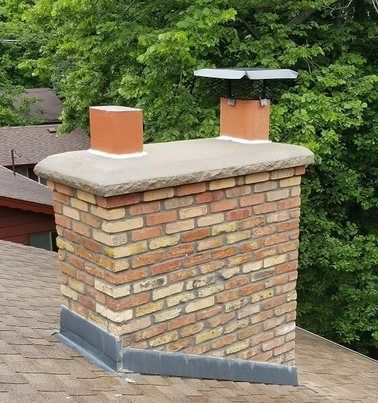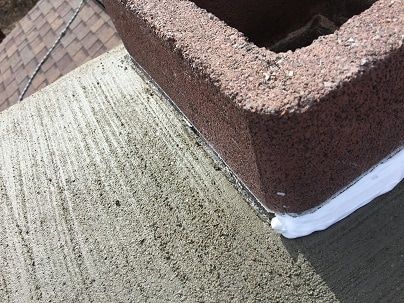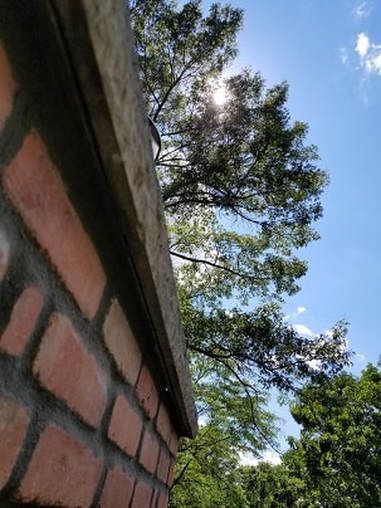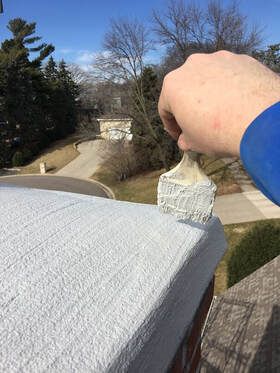Twin Cities Furnace Cleaning - Open 7 Days a Week 8AM to 8PM
Chimney Crown
Your chimney crown serves as the roof or lid of your chimney, covering its entirety except for the flue, thus allowing for the escape of smoke and fumes. It is made from cement and serves to seal off the top of the chimney and protect its interior. A crown in poor condition will allow moisture into the chimney system, causing deterioration and generally wreaking havoc. Protecting the inner workings of your chimney with a properly built crown will extend its life and mitigate the risk of countless common chimney problems.

Chimney Crown Replacement
During crown replacement or rebuilding, the technician will remove the damaged crown by grinding fracture point lines, then use a chisel and mason hammer to take it apart, slowly and carefully so as not to damage the underlying structure. Fiber cement board is laid across the surface, brick to brick, and the flues are wrapped in expansion joint material (a key step in preventing expansion cracks and crown damage). A drip edge is placed around the periphery of the crown, which will act as an umbrella. Next the concrete is poured, and metal mesh is set in the concrete. As the concrete dries, it adheres to the waffle-like material, giving it something to "grab onto," and then, once hardened, holds firm. Finally, the concrete is shaped into a slope on all four sides, for ease of water runoff, then brushed.

Expansion Joint
The expansion joint is a crucial element of the chimney reconstruction process. It consists of a 1/8-inch layer of foam installed around the flue tile. Installation of an expansion joint ensures that the flue tile has the proper room to expand and contract. When a fire is lit in the fireplace, the smoke climbs up the flue, causing the flue tile to heat up and swell. During this swelling, it is necessary that there be proper room between the concrete crown and the flue tile to accommodate the expansion. Without the expansion joint, the crown will crack. If even the smallest of cracks forms, water penetrates the area and begins the erosion process. An expansion joint prevents this.

Chimney Crown Drip Edge
The drip edge is another vital component of crown replacement. The CSIA (Chimney Safety Institute of America) requires at least a 2-inch drip edge. Without a drip edge on the crown, water would simply run down the face of the brick, posing a serious threat to the integrity of the structure. Water drippage can lead to spalling of the brick and erosion of the mortar joints. Further, as the water trickles down the brick it finds crevices and cracks and penetrates the chimney structure itself. Once this occurs the water has the potential to pool, and, if the temperature is below freezing, these pools freeze and later expand, causing major damage. A drip edge acts as an umbrella, allowing water to fall off the crown without contacting the upper chimney, minimizing water damage. An additional best practice in the industry (and a CSIA recommendation) is to grind a "drip line" into the underside of the limestone edge, to ensure water cannot roll back and make contact with the chimney. Once water hits the drip line, it drops without making contact.

Waterproof Crown Sealing
Water is your chimney's number-one enemy. A waterproof crown sealant serves to protect your chimney crown from water damage and extend its life. The mason will first use a coarse wire brush to rough up the surface of the crown for improved adhesion. The application of the sealant, over the entirety of the crown, stops existing cracks from expanding and prevents the growth of new ones. For this job, our masons prefer ChimneySaver CrownSeal, which "forms a flexible, waterproof membrane specifically formulated to repair and protect chimney crowns from water intrusion." The advantage of this product over other similar products is that it is 100% breathable. So while traditional sealants can trap moisture inside, ChimneySaver is vapor-permeable, thus minimizing spalling, cracking, and other deterioration resulting from trapped moisture and freeze-thaw cycles.
Crown Repair
At times, the cost of completely replacing a crown can be prohibitive. If this is the case, and deterioration is not excessive (e.g. mostly hairline cracks), an affordable alternative could be the application of ChimneySaver Crowncoat, which halts further water penetration and serves to protect the crown. After the technician fills the larger cracks and holes with patching cement, two coats of CrownCoat are applied to restore and seal the chimney. CrownCoat carries a 15-year warranty. Crown repair/restoration can be considered a way of "buying time" by halting water damage to the crown until a full replacement can be carried out.
REQUEST A FREE ESTIMATE
Complete the form below regarding your chimney repair project, and we'll reach out to schedule an estimate at a time that works for you!
Contact Us
We will get back to you as soon as possible.
Please try again later.
FOLLOW US
Twin Cities Furnace Cleaning, Inc.
7627 Dallas Ln N
Maple Grove, MN 55311
Phone (call or text)
612-558-1737
E-mail
support@TwinCitiesFurnaceCleaning.com
Twin Cities Furnace Cleaning
7627 Dallas Ln N, Maple Grove, MN 55311
Highly-rated local HVAC cleaning company based out of the Twin Cities.
Open 7 days a week, 8AM to 8PM
Privacy policy found here.
Copyright 2024 Twin Cities Furnace Cleaning, Inc.
(Please note that we will take legal action against any Companies & Organizations that plagiarize our website)
